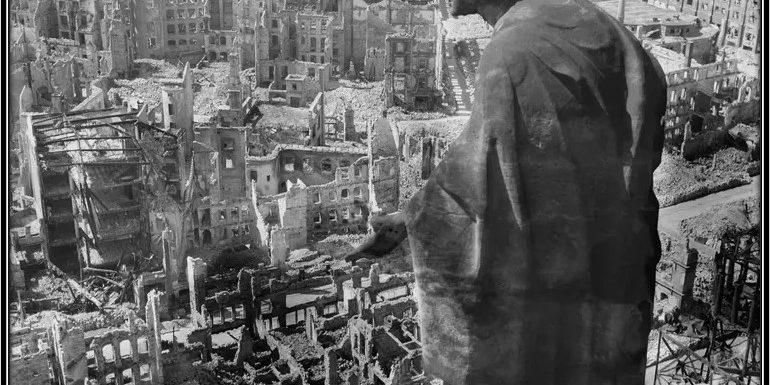A February 13th Twofer
Contributor: Barry Fetzer
Sources: History.com
It is said that, “To the victors go the spoils”. According to a web search on Bing, this term is a “proverbial expression that means the winner of a contest not only wins the subject of the contest, but receives all additional benefits as well. The expression originated in America in 1832, when Senator William Marcy of New York said, ‘They see nothing wrong in the rule that to the victor belongs the spoils of victory’”.
We’ve also heard a similar expression, “History is always written by the winners,” also a proverbial expression, this one attributed to Napoleon according to Bing.
It could be argued that the German people deserved everything they got in their defeat in WWII…and deserved even more (or worse). And what they got, perhaps, has been covered less than what they “gave” in their tragic, horrific, and ill-conceived aims to destroy Judaism and other groups they deemed as inferior and establish a “1000-year Reich”. The destruction of the German Reich and suffering of the German people have been suppressed a bit, it could be argued, by the winners…winners who wrote (and continue to write) the history and the winners who “took the spoils”.
One such destructive mission against the German people that, in retrospect, may not have been necessary was the firebombing of Dresden. On this day in aviation history, on the evening of February 13, 1945, and according to History.com, “a series of Allied firebombing raids began against the German city of Dresden, reducing the ‘Florence of the Elbe’ to rubble and flames, and killing roughly 25,000 people. Despite the horrendous scale of destruction, it arguably accomplished little strategically, since the Germans were already on the verge of surrender.

The view from the tower of the City Hall (Rathaus) southwards over the destroyed city of Dresden with the “Bonitas” sculpture (Allegory of Goodness).
Photographed by Richard Peter.
“Among the conclusions reached at the February 1945 Yalta Conference of the Allied powers was the resolution that the Allies would engage in concerted strategic bombing raids against German cities known for war-production and manufacturing, in an effort to bring the Nazi war machine to a crashing halt. The tragic irony of the raid on Dresden, a medieval city renowned for its rich artistic and architectural treasures, is that during the war it had never been a site of war-production or major industry.
“Both Allies and Germans alike have argued over the real purpose of the firebombing; the ostensible “official” rationale was that Dresden was a major communications center and bombing it would hamper the German ability to convey messages to its army, which was battling Soviet forces at the time. But the extent of the destruction was, for many, disproportionate to the stated strategic goal—many believe that the attack was simply an attempt to punish the Germans and weaken their morale.
“More than 3,400 tons of explosives were dropped on the city by 800 American and British aircraft. The firestorm created by the two days of bombing set the city burning for many more days, littering the streets with charred corpses, including many children. Eight square miles of the city was ruined, and the total body count was between 22,700 and 25,000 dead, according to a report published by the city of Dresden in 2010. The hospitals that were left standing could not handle the numbers of injured and burned, and mass burials became necessary.
“As shocking as such an enormous number of dead is, it did not stand out in the war’s history of ‘strategic bombing’ of cities. Most German cities had been flattened by 1945, and many left higher proportionate death rates and degrees of destruction. The bombing of Hamburg in July 1943 generated the first large firestorm and killed more than 30,000 civilians. And while the German Blitz over England became the subject of many books and movies, the Luftwaffen raids on Eastern European cities such as Belgrade (more than 17,000 dead) or Warsaw (up to 25,000 dead) were far more deadly—to say nothing of non-nuclear city bombings in Japan (by the Allies).” (History.com)
And one more aviation vignette for today: Interestingly exactly 20 years after Dresden and from the history does seem to repeat itself department and according to History.com, on February 13, 1965, “President Lyndon B. Johnson decided to undertake the sustained bombing of North Vietnam that he and his advisers have been contemplating for a year.
“Called Operation Rolling Thunder, the bombing campaign was designed to interdict North Vietnamese transportation routes in the southern part of North Vietnam and slow infiltration of personnel and supplies into South Vietnam. The first Rolling Thunder mission took place on March 2, 1965, when 100 U.S. Air Force and Republic of Vietnam Air Force (VNAF) planes struck the Xom Bang ammunition dump 100 miles southeast of Hanoi.

A photo shot from the Dash-Two Phantom during Operation Rolling Thunder. Courtesy Getty Images.
“From 1965 to 1968, about 643,000 tons of bombs were dropped on North Vietnam, and a total of nearly 900 U.S. aircraft were lost during Operation Rolling Thunder. The operation continued, with occasional suspensions, until President Johnson, under increasing domestic political pressure, halted it on October 31, 1968″ (History.com)







